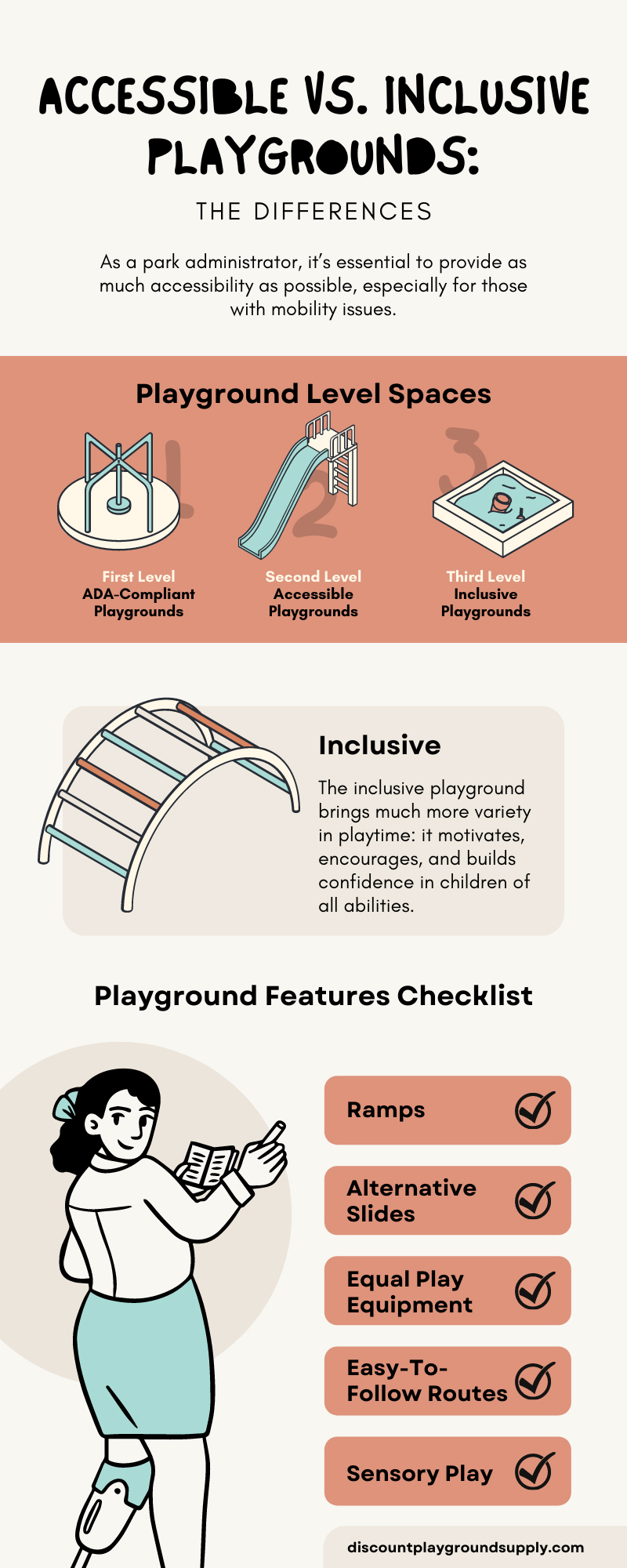
As a park administrator, it’s essential to provide as much accessibility as possible, especially for those with mobility issues. However, you can only go so far with designs until the parks no longer feel inclusive. So, let’s take a deeper dive into what exactly the difference is between inclusive and accessible playgrounds.
Inclusive and Accessible: The Difference
In 1990, President George H. W. Bush signed an act into law that prohibited discrimination against those with disabilities, especially in playground or park settings.
However, even after this act was signed into law, parks barely did anything to make the parks genuinely inclusive. For example, they would design a playground only for those with disabilities, but these parks were found only in cities.
Additionally, many other families assumed these playgrounds were for seniors or younger children. Once it came to the attention of local governments, many pushed for parks to be inclusive rather than having a separate section that’s secluded and damaged by others.
Let’s dig in a little more into what exactly inclusive and accessible represent.
Accessible
Many can define accessibility as a way to get onto the playground without issue, especially for those in wheelchairs. The definition also centers around playing on the equipment with ease with no further help as we look more into the meaning.
Inclusive
We define inclusiveness as a way for children of all ages, backgrounds, and abilities to come and play on equipment that enables play for all. Once engaged, children with mobility issues feel as if they’re conquering the world one day at a time playing on an inclusive playground.
What many can learn from here is that accessibility does not equate to inclusiveness. With many parks becoming modern and updating their best features, they still leave elements to continue being inclusive.
Let’s swim to the bottom of these differences. Here’s every playground level space and what it means for all-encompassing and open playgrounds.
Playground Level Spaces
Every park that aims to become ADA-compliant needs to ensure that postage is up and that the equipment meets common safety standards and codes as listed by the ADA.
First Level—ADA-Compliant Playgrounds
In many of the beginning stages, parks first start as being considered ADA-compliant, even though they have little equipment to use.
For starters, parks considering themselves ADA-passing hardly change their current design, leading them into the second phase of building accessible playgrounds.
Second Level—Accessible Playgrounds
There’s more to ADA-compliancy than simply building a separate area dedicated to those with disabilities. To start, the government has issued many different ways to incorporate accessibility play areas into their design, such as wheelchair ramps and commercial grade swingset hardware to add variety.
Eventually, the designs become a little too cut off, so designers need to think more out of the box to help meet the needs of all families with children that do or don’t have a disability. This brings them to the third phase: an inclusive playground.
Third Level—Inclusive Playgrounds
The inclusive playground brings much more variety in playtime: it motivates, encourages, and builds confidence in children of all abilities. The best part of an inclusive playground is that children interact and learn to play together, no matter if they’re in a wheelchair.
An inclusive playground has also helped families with special needs children, such as children afflicted by autism and down syndrome. Since these two groups become prone to unhealthy lifestyles, it’s just as important to send them outside when there’s a play area nearby to help them learn about being healthy.
Inclusive Playground Highlights
There’s a lot both types of parks can offer, but inclusivity is the best option for restructuring a play area. Here’s what each characteristic of an inclusive playground looks like.
Equal Play Equipment
The best part about the park is the equipment; however, some often exclude certain kids. So, to make the park fun for everyone, use equal play equipment, as it encourages children to play together and learn about each other differently.
Easy-To-Follow Routes
Routes become much easier to follow, especially if they’re paved roads that don’t have hurdles to get through. Many enjoy going to the park, so having accessible routes with no rocks or other obstructions in the way can allow others to take the trails to different ends of the area.
Sensory Play
Another essential thing is sensory play. The sensory play explores every sense around a child. From smelling flowers to feeling the grass, a child that has enough calm colors and natural elements around them can help them learn the difference between what smells funny a what feels hard.
Accessible Playground Features
Accessibility is important, but sometimes it’s not taken care of as well as other equipment. So, as you build more gear, focus on adding other additions to the park to make it accessible for those that use a wheelchair.
Here are the characteristics of accessible playgrounds.
Ramps
The most important part of making the play area accessible is adding ramps. A ramp with obstacles can make the trip up and down the platform easier. Plus, it helps make it more accessible by adding rails on both sides to help with pulling oneself up the ramp.
Alternative Slides
You might not think it’s possible to have an alternative slide, but they do exist for children in wheelchairs and other disabilities. With the help of a different slide style, the park becomes a little more diverse for everyone.
The Benefits of Inclusive Playgrounds
There are many reasons to have an inclusive playground. For starters, it brings everyone of all ages together to form friendships with different individuals. Aside from benefitting other children with a play area that encourages everyone to play, you help create a better perspective on how an inclusive park should look.
Start benefitting families and bringing together for more than an hour of play. Here are some other benefits you can gain from building an inclusive park:
- Family time
- Build self-esteem
- Child development improves
Even as you come to the end of our discussion on the differences between inclusive and accessible playgrounds, now’s the time to sit down with your designers and discuss how you can make the park a place for everyone.
As a park administrator, you’re going to wonder about the right equipment to buy for your new, improved playground. At Discount Playground Supply, we can help with guiding you in the process of making your park more inclusive. Contact us here for more information.


